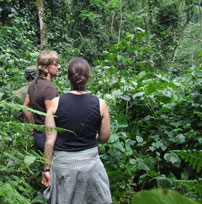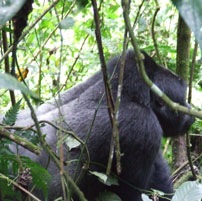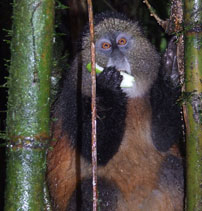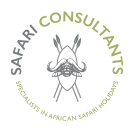I’ve recently returned from a journey through Uganda and Rwanda where I saw some of Africa’s most endangered primates.
Populations of mountain gorilla now number less than 500 in  Uganda and around 300 in Rwanda, and whilst it hasn’t been possible to determine the extent of the endangered golden monkey population, they face the same threats as the gorillas, including snares set for small antelope, human encroachment and people entering their habitat to collect wood. A trip to either country also offers the opportunity to view charismatic chimpanzees and other primates such as the rather sad looking, but easily recognisable black and white colobus monkey.
Uganda and around 300 in Rwanda, and whilst it hasn’t been possible to determine the extent of the endangered golden monkey population, they face the same threats as the gorillas, including snares set for small antelope, human encroachment and people entering their habitat to collect wood. A trip to either country also offers the opportunity to view charismatic chimpanzees and other primates such as the rather sad looking, but easily recognisable black and white colobus monkey.
Our journey started in bustling Kampala and a seven hour drive took us to Kyambura Gorge, close to Queen Elizabeth National Park. A stay in this area will most certainly include game drives in the QENP, and a boat cruise on the Kazingo Channel, a good opportunity for viewing elephants and varied birdlife. However, the attraction for primate lovers in this area are the chimpanzees in the gorge.
Deforestation has meant that the usual corridors for chimpanzee movement have disappeared but one family remains and continues to survive within the Kyambura.
After a steep descent into the gorge, the hiking through the forest is lovely, enjoying the scenery and criss-crossing the river by walkways and rafts, all the time looking and listening for signs of the chimpanzees. We trekked for four and a half hours and didn’t see one chimp which just goes to show that that this is truly wild trekking and certainly in the case of Kyambura, where the success rate is between, 40 and 60%, there are never any guarantees!!
Having limbered up with the chimp trek, next stop was the aptly named Bwindi Impenetrable Forest, home to Uganda’s mountain gorillas. At an altitude of well over 2000 metres, trekking in Bwindi is done at a slow pace, but it remains very challenging.
Our starting point was a 45 minute drive from the park HQ in the village of Buhoma and having teamed up with our porters, we began to walk. After an initial ascent through cultivated lands, we entered into the cool of the forest and the vegetation closed around us. A fallen tree blocked our way, so a detour was made, climbing over roots and squeezing between entangled vines with our porters supporting and encouraging us all the time.
 Finally, word came through that the gorillas had been found and we saw fleeting movement as they disappeared down into the valley. So, we followed – sliding down the steep slope using any vegetation we could to keep us steady until we reached the bottom and suddenly, there they were.
Finally, word came through that the gorillas had been found and we saw fleeting movement as they disappeared down into the valley. So, we followed – sliding down the steep slope using any vegetation we could to keep us steady until we reached the bottom and suddenly, there they were.
For an hour we stayed with them, moving as they moved and eventually sitting down to observe as they settled down to eat. What incredible animals they are, displaying such patience as they allowed us to watch their interaction and play, but all too soon, the hour, which is strictly monitored, was up and we began the long trek home. Somehow our steps were much lighter.
As soon as you cross the border into Rwanda, you notice differences – the first one being the amount of people. Rwanda has a population of just over 11 million and sometimes it feels like they are all out on the streets at the same time, walking or cycling or on the back of the numerous moto taxis.
Gorilla trekking in Rwanda takes place in the beautiful Parc des Volcans, a dramatic range of volcanoes marking the borders between Uganda, Rwanda and the Democratic Republic of Congo. It was here that Dian Fossey made her name and you can trek to her grave in the shadow of the largest volcano, Karisimbi.
Parc des Volcans, a dramatic range of volcanoes marking the borders between Uganda, Rwanda and the Democratic Republic of Congo. It was here that Dian Fossey made her name and you can trek to her grave in the shadow of the largest volcano, Karisimbi.
Having trekked for gorillas in Rwanda some five years ago, I opted this time to see the golden monkeys. The trekking is not nearly as intense, nor as long, as for gorillas but the hour spent with the monkeys is really magical as these small primates feed, groom and play in the trees. This is an excellent and more affordable trekking option, in place of a second gorilla trek.
